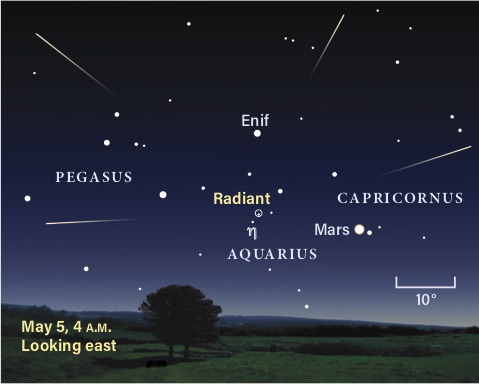The Sky This Week from May 1 to 8 – Astronomy Magazine
Eta Aquariid meteor shower
Partly due to the low altitude of the Eta Aquariids’ radiant when viewed from northern latitudes, the shower is not considered one of the year’s best. But with Mars hovering in the nearby sky this year, it’s worth taking the time to view it.
Astronomy: Roen Kelly
The Eta Aquariid meteor shower, which has been active since late April, peaks this morning. Although this shower tends to put on a strong show in the Southern Hemisphere, its low radiant in the Northern Hemisphere results in a predicted rate of 10 meteors per hour at its peak. But with good weather and a bit of luck, you may still catch some of the shower’s meteors this morning.
Mars hangs near the Eta Aquariids’ radiant, low in the sky around 4 A.M. local time. Although it’s typically best to concentrate on an area opposite the radiant in the sky, a bright waxing Moon is setting in the west, nixing that plan of attack. Instead, scan the other three quadrants of the sky to catch errant shooting stars. These are the debris left behind by the famous Comet 1/P Halley, which last graced our skies in 1986 and will return in the early 2060s.
Tonight, the Moon will reach perigee — the closest point in its orbit to Earth — at 11:03 P.M. EDT. It will then sit 223,478 miles (359,653 kilometers) from our planet.
Wednesday, May 6
Not to be shown up by its fellow Galilean satellites, Jupiter’s moon Io and its shadow cross the face of the gas giant this morning. The whole thing starts at 2:59 A.M. EDT, as Io’s shadow slips into view on Jupiter’s eastern limb. At 4:13 A.M. EDT, Io begins to cross in front of the same limb, with its shadow more than halfway across the planet’s face. An hour later, the moon’s shadow disappears, with the moon slipping off the planet’s disk beginning at 5:29 A.M. CDT. (East Coast observers will miss this finale as the Sun rises and interrupts the show.)
Thursday, May 7
Full Moon occurs at 6:45 A.M. EDT. Rising as the Sun sets tonight, our satellite’s bright light will wash out much of the dark sky. But that doesn’t mean there aren’t still tempting targets to observe. The Beehive Cluster (M44) is a large open cluster in the constellation Cancer the Crab. Also known as Praesepe, this cluster is one of the closest to Earth at around 600 light-years away. The entire cluster covers an area nearly three Full Moons in size and contains 1,000 or so stars. On a dark night, it’s visible to the naked eye; even on this bright, moonlit night, you’ll be able to catch several of the cluster’s young stars in binoculars or a telescope. More will pop out as you move to larger apertures.






